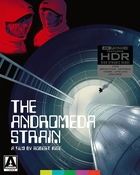BLU-RAY REVIEW

The Andromeda Strain 4K Ultra HD
Featured In Issue 278, March/April
In "The Andromeda Strain," a government satellite outside the small town of Piedmont and within minutes, every inhabitant is dead, except for a crying baby and an elderly derelict. (Gary Reber(
Special features include commentary by critic Bryan Reesman; The featurettes: "A New Strain Of Science Fiction: (HD 28:02), "The Andronmeda Strain: Making The Film (HD 30:08), "A Portrait Of Michael Crichton" (SD 12:33) and "Cinescript Gallery"; theaatrial trailer; image gallery; illustrated collector's booklet and reversible sleeve,
The 2.35:1 2160p HEVC/H.265 Ultra HD Dolby Vision/HDR10 picture, reviewed on a VIZIO Quantum X P85QX-JI UHD/HDR display, was photographed on 35 mm film in anamorphic Panavision® using Panavision Panaflex cameras and fully restored from the original camera negative by Arrow Video. It has been sourced from a 4K master Digital Intermediate format. Film grain is virtually absent. The settings are the lifeless town of Piedmont, the desert in Nevada and the underground research facility. At times, Director Robert Wise uses innovative split-screen imagery. The imagery appears realistic and natural. Color fidelity, especially in the red-walled underground facility, exhibit realistic hues. Reds are solid and vivid. Flesh tones appear natural throughout. HDR contrast is excellent, especially in the underground laboratory. Blacks are deep and solid. Shadows are revealing. White level illumination is realistic. Resolution is excellent, especially during closeups of facial features and animal hair. Facial features reveal skin pores, lines, sweat and hair. Settings, backgrounds and objects are nicely detailed. This is an excellent restoration of a 1971 classic science fiction film. (Gary Reber)
The soundtrack reportedly was a six-track mix for 70mm release in Europe and Australia, but always a mono mix for releases in the United States. The original LPCM monaural soundtrack is well-crafted with sound elements that are presented with excellent clarity. Atmospherics are nuanced with the sound of din in the underground research facility. Sound effects are numerous throughout, some loud, such as helicopter engine and blades and loud alarms and alerts, and other unique sounds. Others, such as nuanced scientific apparatus machine noises., are also numerous. There also is endless announcements of techno-announcement over the P.A. system. As such, The Wildfire facility has a constant barrage of mechanical and electronic sound effects. Gil Mellé's music is produce by a synthesizer and provides unique sounds. Dialogue is mostly intelligible throughout with good spatial integration. While fidelity is dated, the sonics are effectively clear. (Gary Reber)

 then "Add to Home Screen"
then "Add to Home Screen"